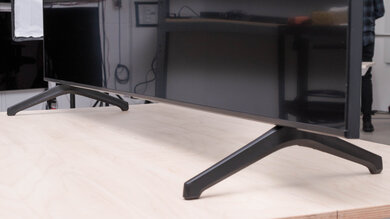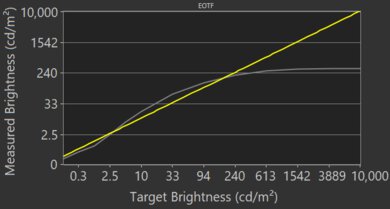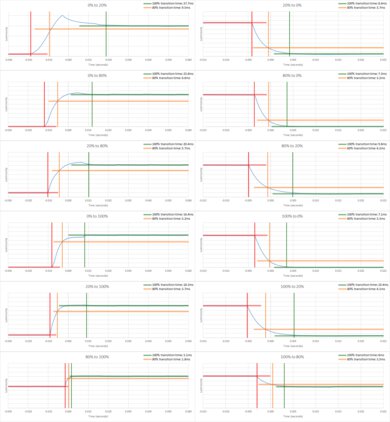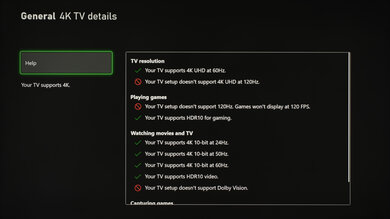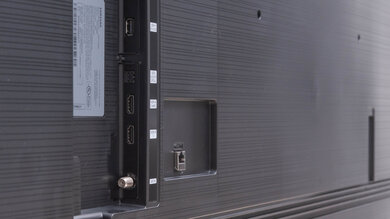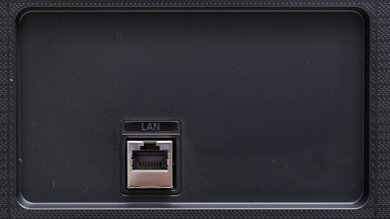The Samsung TU6980 is a decent entry-level 4k TV. It's a variant of the Samsung TU7000, and the 70 inch model we tested is one of two options in Samsung's 6 Series lineup, with the other being an 82 inch model. It has a VA panel with a good contrast ratio, but it's lower than most other VA panel TVs, and there's no local dimming to improve it. It has incredibly low input lag and a quick response time for gaming, and there's a Black Frame Insertion feature to improve the appearance of motion. Sadly, HDR content doesn't look all that different from SDR content because it fails to display a wide color gamut and has disappointing peak brightness. Fortunately, it doesn't have any issues upscaling lower-resolution content, such as from cable boxes or Blu-ray players. Also, the built-in Tizen OS is easy-to-use and there are a ton of apps available to download.
Our Verdict
The Samsung 6 Series is a decent TV for most uses. It's good for gaming as it has a quick response time, a Black Frame Insertion feature, and incredibly low input lag. It performs well in dark environments because of its good contrast, but it has only decent black uniformity and lacks local dimming. Sadly, it has narrow viewing angles, so it's not suggested for wide seating arrangements when watching TV or sports with a large group of people.
- Good contrast ratio.
- Good response time.
- Incredibly low input lag.
- Doesn't get bright enough to combat a ton of glare.
- Narrow viewing angles.
- Can't display wide color gamut for HDR content.
The Samsung 6 Series is okay for watching movies. It has a good contrast ratio, but it's not as good as some other TVs with a VA panel. Black uniformity is only decent, and there's no local dimming feature. Luckily, it removes judder from native 24p sources, such as Blu-ray players or native apps.
- Good contrast ratio.
- Removes judder from native 24p sources.
- Only decent black uniformity.
- No local dimming feature.
The Samsung 6 Series is decent for watching TV shows. Its peak brightness isn't bad and it has decent reflection handling, but it's best to avoid using it in bright rooms. It upscales lower-resolution content, such as from cable TV, without any issues. Sadly, it has narrow viewing angles, so you quickly lose image accuracy when viewing off-center.
- Decent reflection handling.
- Upscales lower-resolution content well.
- Doesn't get bright enough to combat a ton of glare.
- Narrow viewing angles.
The Samsung 6 Series is decent for sports. It has a good response time and a Black Frame Insertion feature to help improve the appearance of motion. It handles reflections fairly well and its peak brightness isn't bad, but it's not good enough to combat a lot of glare. Also, it's not suggested for wide seating arrangements because it has narrow viewing angles.
- Decent reflection handling.
- Upscales lower-resolution content well.
- Good response time.
- Doesn't get bright enough to combat a ton of glare.
- Narrow viewing angles.
- Dirty screen effect in the center.
The Samsung 6 Series is good for video games. It has incredibly low input lag, a quick response time, and a Black Frame Insertion feature to clear up motion blur. It's good for dark-room gaming because of its good contrast ratio. Sadly, it doesn't have variable refresh rate support and lacks local dimming.
- Good contrast ratio.
- Good response time.
- Incredibly low input lag.
- Only decent black uniformity.
- No variable refresh rate support.
The Samsung 6 Series is mediocre for watching HDR movies. It fails to display a wide color gamut and doesn't get bright enough in HDR to make highlights stand out. It has a good contrast ratio, but the black uniformity is just decent and there's no local dimming feature.
- Good contrast ratio.
- No local dimming feature.
- Can't display wide color gamut for HDR content.
- Disappointing HDR peak brightness.
The Samsung 6 Series is decent for HDR gaming, mainly due to its good gaming performance. It has low input lag and a good response time to deliver a responsive gaming experience. It has a good contrast ratio, but HDR content doesn't look good because it can't display a wide color gamut, has disappointing peak brightness, and there's no local dimming feature.
- Good contrast ratio.
- Good response time.
- Incredibly low input lag.
- No local dimming feature.
- Can't display wide color gamut for HDR content.
- Disappointing HDR peak brightness.
The Samsung 6 Series is a good choice for use as a PC monitor. It displays chroma 4:4:4 at any resolution, which is important for reading fine text. It also has incredibly low input lag and a quick response time. It has decent reflection handling and performs well in a moderately-lit room. Sadly, it has narrow viewing angles, so the edges look washed out if you sit too close.
- Decent reflection handling.
- Incredibly low input lag.
- Displays chroma 4:4:4.
- Doesn't get bright enough to combat a ton of glare.
- Narrow viewing angles.
Changelog
- Updated Nov 22, 2022: The TU690T variant was incorrectly referred to as the ‘TU690’. The review has been updated.
- Updated Nov 16, 2022: Added the Samsung TU690 Black Friday 2022 variant to the Differences Between Sizes and Variants section of the review.
- Updated Mar 01, 2021: Converted to Test Bench 1.6.
- Updated Nov 12, 2020: Review published.
Check Price
Differences Between Sizes And Variants
We tested the 70-inch Samsung TU6980, which is only sold at Best Buy for Black Friday. There's also a variant available at Best Buy known as the TU6985 and we expect them to perform the same. There's an 82-inch variant known as the TU6950 that's sold at other retailers, and we expect our review to be valid for that model as well. There's also a Black Friday variant of this TV available in a wide range of sizes, known as the Samsung TU690T.
Overall this TV is a variant of the Samsung TU7000, but it performs closer to the Samsung TU8000.
| Size | Model | Black Friday 2022 Variant | Notes |
|---|---|---|---|
| 43" | N/A | UN43TU690TFXZA | |
| 50" | N/A | UN50TU690TFXZA | |
| 58" | N/A | UN58TU690TFXZA | |
| 60" | N/A | UN60TU690TFXZA | |
| 70" | UN70TU6980FXZA | Best Buy exclusive | |
| 70" | UN70TU6985FXZA | Expect to be identical to the TU6980 | |
| 75" | N/A | UN75TU690TFXZA | |
| 82" | UN82TU6950FXZA |
If someone comes across a different type of panel or if their Samsung TU6900 Series doesn't correspond to our review, let us know and we will update the review. Note that some tests, such as gray uniformity, may vary between individual units.
Our unit was manufactured in September 2020 and you can see the label here.
Popular TV Comparisons
The Samsung 6 Series is a decent entry-level TV, especially for its price. It performs better than the Samsung TU7000 and is closer to the Samsung TU8000. Although it has a lower contrast ratio than other TVs with VA panels, it gets brighter and has a quicker response time than other options in its price range. Also see our recommendations for the best 70-75-77 inch TVs, the best budget TVs, and the best Samsung TVs.
The Samsung TU6980 is slightly better than the Vizio V Series 2020. The Samsung gets brighter, does a better job at upscaling 480p and 720p content, and has a much quicker response time. However, the Vizio has a better contrast ratio, better black uniformity, and better reflection handling.
The Samsung TU6980 is better than the LG UN8500, but they have different panel types. The Samsung has a VA panel with a better contrast ratio. It also gets brighter, displays native 4k content better, and it has a Black Frame Insertion feature and lower input lag. However, the LG has an IPS panel with wide viewing angles, and it also has a slightly quicker response time.
The Samsung TU6980 is better than the LG NANO80 2020, but they have different panel types. The Samsung has a VA panel and displays much deeper blacks. It also gets brighter, has a quicker response time, and a Black Frame Insertion feature. However, the LG has an IPS panel with wider viewing angles, it displays a wide color gamut, and has better gradient handling.
The Samsung TU6980 is a bit better than the LG UN6970, but they use different panel types. The Samsung has a much better contrast ratio due to its VA panel. It also gets brighter in SDR, has much better color accuracy, and has a Black Frame Insertion feature. However, the LG has an IPS panel with wide viewing angles, it gets brighter in SDR, and has much better gradient handling.

We buy and test dozens of TVs yearly, taking an objective, data-driven approach to deliver results you can trust. Our testing process is complex, with hundreds of individual tests that take over a week to complete. Most of our tests are done with specially designed test patterns that mimic real content, but we also use the same sources you have at home to ensure our results match the real-world experience. We use two main tools for our testing: a Colorimetry Research CR-100 colorimeter and a CR-250 spectroradiometer.
Test Results

The Samsung 6 Series has an excellent design. It looks a lot like the Samsung TU7000 with thin borders and a textured finish on the back panel. It has different feet and it's thinner than other entry-level Samsung models in 2020, but sadly, there's no cable management.
The Samsung 6 Series has wide-set feet that support the TV well. The feet are placed more at an angle compared to the Samsung TU7000, and there's enough room to place a soundbar without obstructing the screen. You can't place the feet in a reverse position or move them to accommodate smaller tables.
Footprint of the 70" TV: 49.5" x 13.5"
The back of this TV is plastic with a brushed textured finish. There are tracks at the bottom, but without any clips on the legs, they don't help with cable management.
The Samsung 6 Series is even thinner than the Samsung TU8000 and doesn't stick out when wall-mounted.
The Samsung 6 Series has a decent build quality, much like the Samsung TU7000 and Samsung TU8000. It's made entirely out of plastic and there aren't any obvious issues, but at the same time, there's nothing premium about it.
The SDR peak brightness isn't bad and it's much better than the Samsung TU7000. It gets bright enough to combat some glare, but it's best to avoid placing it in well-lit rooms. It maintains its brightness consistent for the most part, but small highlights aren't as bright due to the frame dimming.
We measured peak brightness after calibration in the 'Movie' Picture Mode with Gamma set to '2.2', Contrast at its default setting, and Brightness at its max.
If you don't care about image accuracy and want the brightest image possible, set the Picture Mode to 'Movie', Contrast Enhancer to 'High', Color Tone to 'Cool', and Contrast at its max. We achieved 311 cd/m² in the 10% window using these settings.
This TV doesn't have a local dimming feature. The video above is provided for reference only.
The Samsung TU6900 has disappointing HDR peak brightness. It only gets a bit brighter than in SDR, and it doesn't get bright enough to bring out highlights. Once again, small highlights aren't as bright due to the frame dimming.
We measured HDR peak brightness in the 'Movie HDR' Picture Mode with Contrast and Brightness at their max. If you want an even brighter image and don't mind losing accuracy, use these settings with Contrast Enhancer on 'High' and ST.2084 set to '+3'. We achieved 320 cd/m² in the 10% window.
Our unit of the Samsung 6 Series has decent gray uniformity, but this may vary between units. The edges of the screen are visibly darker and there's dirty screen effect in the center. The uniformity is much better in near-dark scenes, but there's still some slight backlight bleed along the edges.
The reflection handling is decent, much like the Samsung TU8000. It performs best in moderately-lit rooms, but the reflections may be too distracting if it's placed opposite a window with direct sunlight.
The Samsung 6 Series has very good out-of-the-box accuracy. Most colors and white balance are only slightly inaccurate, and most people shouldn't notice it. Color temperature is almost exactly spot on our 6500K target. Gamma follows the target curve fairly well overall, but dark scenes are too dark and other scenes are too bright.
After calibration, the color accuracy is remarkable. Any remaining inaccuracies with colors and white balance can't be spotted by the naked eye. The color temperature became slightly cooler from before calibration, but it's still extremely close to the target. Gamma follows the target curve almost perfectly, except really dark scenes are still too dark.
See our recommended settings here.
This TV uses a BGR subpixel layout, which can affect the way text is rendered when using it as a PC monitor. You can read about it here.
The Samsung TU6900 has an okay color gamut, but it's not considered a wide color gamut needed for HDR content. It has good coverage of the commonly-used DCI P3 color space, but limited coverage of the wider Rec. 2020.
The EOTF follows the target PQ curve fairly well, but all scenes are darker than they should be. The image in 'Game' mode is brighter, as you can see in this EOTF.
If you find HDR too dim and want a brighter image, set the Contrast Enhancer to 'High', ST.2084 to '+3', Tone Color to 'Cool', and Brightness and Contrast at their max in the 'Movie HDR' Picture Mode. This results in a brighter image, as you can see in this EOTF. You can also adjust Shadow Detail to '+5', as seen in this EOTF, but this results in blacks that look gray and we don't recommend it.
The Samsung 6 Series has a disappointing color volume. It's mainly limited by its lack of a wide color gamut, and it can't display colors at a wide range of luminance levels.
This TV has okay gradient handling. There's banding in all colors, and it's most noticeable with green and gray. The Noise Reduction setting doesn't improve the gradients at all. If gradient handling is important to you, look into the LG NANO80.
We don't expect VA panels to experience burn-in, as the VA panel in our long-term test appears immune.
There's an optional Black Frame Insertion feature to help reduce motion blur. It's called LED Clear Motion, and it flickers at 60Hz outside of 'Game' mode and 120Hz in 'Game' mode.
The Samsung 6 Series has a motion interpolation feature to interpolate lower-frame rate content up to 60fps. It works great on our test pattern, but there are a few artifacts with real content. However, it isn't bad and depends on the content.
See here for the settings that control the feature.
Despite having a quick response time, there's not much stutter with lower-frame rate content. Enabling the motion interpolation feature can help reduce stutter if you notice it.
The Samsung 6 Series automatically removes judder from native 24p sources as long as Picture Clarity is disabled.
This TV doesn't support any variable refresh rate technology.
The Samsung 6 Series has an incredibly low input lag as long as you're in 'Game' mode, and it stays about the same whether you're gaming in 1080p or 4k. You can use the motion interpolation feature in 'Game' mode, but it significantly increases the input lag.
There's an 'Auto Low Latency Mode' that automatically switches the TV into 'Game' mode when a game from a compatible device is launched. For it to work, enable Anynet+ (HDMI-CEC) and set Game Mode to 'Auto'. If you're using this TV as a PC monitor and want the lowest input lag, set the input you're using to 'PC' and enable Game Mode.
This TV supports most common resolutions at 60Hz, including 1440p, which is great for Xbox One gamers or PC users. It also displays chroma 4:4:4 at any resolution, which is important for reading text. Set the icon for the input you're using to 'PC' for it to display chroma 4:4:4. For signals that require full bandwidth, enable Input Signal Plus.
We had issues with HDR10+ during testing, as it didn't work with Amazon Prime Video, but worked with a Blu-ray.
Like the Samsung TU7000, the Samsung 6 Series has eARC support, allowing it to pass high-quality audio to a compatible receiver through a single HDMI connection. For it work, set HDMI eARC Mode to 'Auto' and Digital Output Audio to 'Passthrough' or 'Auto'.
The frequency response is unremarkable. It has a well-balanced sound profile to produce clear dialogue, but it doesn't produce much bass. Also, it doesn't get loud, so it's best to avoid using it in a noisy environment.
The Samsung 6 Series has disappointing distortion performance. It's noticeable even at moderate listening levels, and the distortion increases as the TV gets louder. However, this depends on the content and not everyone may hear it.
Like all other Samsung TVs, the Samsung 6 Series comes with Tizen OS. It's a version with reduced features, but it's still easy to navigate and runs fairly smoothly.
The Samsung 6 Series comes with the same basic remote as the Samsung TU7000. There are a few shortcut buttons to popular streaming devices, but there's no voice control.


